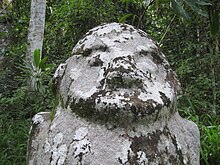Central Sulawesi (Indonesian Sulawesi Tengah) is a province of Indonesia located at the centre of the island of Sulawesi. Its capital and largest city is Palu. The 2010 census recorded a population of 2,633,420 for the province, while the latest official estimate (for January 2014) is 2,839,290.
Established in 1964, Central Sulawesi has an area of 61,841.29 km2 (23,877 sq mi).[1] It is bordered by the provinces of Gorontalo to the north, West Sulawesi, South Sulawesi and South East Sulawesi to the south, by Maluku to the east, and by the Makassar Strait to the west.
Contents
History
Megalithic stone in Central Sulawesi
Central Sulawesi Province has many caves, seven of which have ancient pictures and, based on 2011 research by a joint Indonesian and Australian team, the pictures are known to have been drawn at least 40,000 years ago (about the same age as pictures found in the Caves of Monte Castillo, Spain which are known as the oldest ancient pictures in Europe).[4]
Islam reached the region in the 17th Century, shortly after the Islamic avowal of Gowa, the powerful kingdom at the South part of the Sulawesi island. The Dutch colonial rule was established in the 18th Century and began the protestantic missionary of the population. About a quarter of them are now Protestant, which is the highest percentage of the Indonesien archipelago. After the Japanese occupation in the Second world war, the Region belonged to the Province North Sulawesi and separated in 1964 to the new formed Province Central Sulawesi.
Between 1999 and 2001 the region has been plagued by inter-religious violence between Muslims and Christians, where over 1,000 people were killed.[5] The Malino II Accord was thus made in 2001. However, riots erupted again in September 2006 on the Christian dominated areas of Central Sulawesi, after the execution by firing squad of three Roman Catholics convicted of leading Christian militants during the violence of the early first decade of the 21st century.[6] The riots appeared to be aimed at government authorities, not Muslims.[6]
Administrative divisions
Central Sulawesi is divided into twelve regencies (kabupaten) and one city (kota), which are listed below with their populations at the 2010 Census and according to the latest (for January 2014) estimates.| Name | Area (km2) | Population Census 2000 |
Population Census 2010 |
Population Estimate 2014 |
Capital |
|---|---|---|---|---|---|
| Palu (city) | 395.06 | 269,083 | 335,297 | 362,621 | Palu |
| Banggai Regency | 271,725 | 323,872 | 348,715 | Luwuk | |
| Banggai Islands Regency | 141,175 | 171,685 | 184,933 | Salakan | |
| Banggai Laut Regency | included in Banggai Islands Regency |
included in Banggai Islands Regency |
included in Banggai Islands Regency |
Banggai | |
| Buol Regency | 98,005 | 132,381 | 142,589 | Buol | |
| Donggala Regency | 10,472 | 732,126 | 277,236 | 299,143 | Banawa |
| Morowali Regency | 160,797 | 206,189 | 222,317 | Bungku | |
| North Morowali Regency | included in Morowali Regency |
included in Morowali Regency |
included in Morowali Regency |
Kolonodale | |
| Parigi Moutong Regency | 6,232 | * | 413,645 | 445,652 | Parigi |
| Poso Regency | 232,765 | 209,252 | 225,449 | Poso | |
| Sigi Regency | 5,196 | * | 214,700 | 231,700 | Sigi Biromaru |
| Tojo Una-Una Regency | # | 137,880 | 148,494 | Ampana | |
| Toli-Toli Regency | 173,525 | 211,283 | 227,677 | Toli-Toli | |
| Total Province | 61,841 | 2,175,993 | 2,633,420 | 2,839,290 | Palu |
- * The 2000 Census populations for Parigi Moutong Regency and Sigi Regency are included in the figure for Donggala Regency.
- # The 2000 Census population for Tojo Una-Una Regency is included in the figure for Poso Regency.




0 komentar:
Posting Komentar